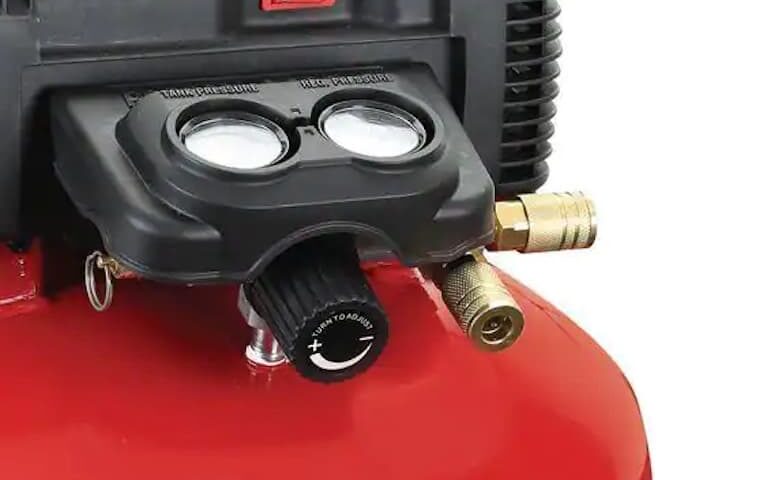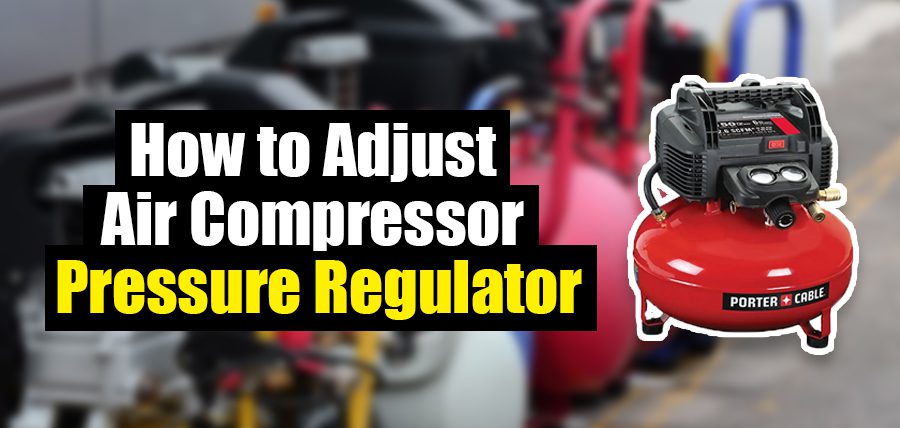If you’re new to the air compressor’s game you’ve probably wondered to yourself “How do you adjust an air compressor air pressure?” Which makes sense, as different air tools (impact wrenches, framing nailers, etc) have different PSI needs.
Well, the answer to that question is pretty simple, yet a bit hard to find online.
This is why I decided to make this quick article that will teach you step by step how to adjust the air pressure outputted by your air compressor.
Let’s begin.
How to Adjust Air Compressor Pressure Regulator
So, let’s talk about how to exactly adjust an air compressor’s pressure regulator to run your pneumatic tools.
There are plenty of ways of doing this, but this is the easiest and more straightforward way:
- Prepare things
- Locate the regulator
- Understand the gauges
- Check air tool’s PSI needs
- Turn the knob to the desired air pressure
Step 1: Prepare things
f you wish to manage the air pressure of your air compressor to power your air tools, you must first ensure that everything is properly set up.
To do this, you must complete a few steps:
- Start the air compressor and let it to warm up. This will ensure that everything goes smoothly.
- Allow the air tank to fill with air pressure (waiting times will vary depending on the model).
- Connect the air tool you want to use to the air hose, and the hose to the air compressors.
Now, everything will be set to properly use the air compressor and set the desired air pressure with the air pressure regulator.
Step 2: Locate the regulator knob and gauges
Believe it or not, there are many air compressor owners who are unfamiliar with their own air compressors.
This is why I added this step which involves identifying where the regulator know and air pressure gauges are located in the air compressors.
As you’ll see in the next step, these elements are critical for altering the air compressor’s outputted air pressure, so keep them in mind at all times.
Step 3: Understanding the gauges
Most air compressors come with two gauges, as you’ll see below:

The first gauge provides information about the air pressure inside the tank, which is important because it limits how much PSI the air compressor can output.
The second gauge displays the exact PSI that the air compressor is capable of delivering to the air tool you have connected.
The knob just below the two gauges is in charge of regulating the second gauge, which represents the air pressure that the air compressor will output.
Step 4: Check air tool’s PSI needs
There are all kinds of pneumatic tools, air impact wrenches, air ratchets and even air sanders, you name it.
Each and every one of them have different PSI needs. This is very important as if you provide the incorrect PSI to a given air tool, you run the risk of wrecking it.
So, if you want to avoid loosing hundreds of dollars in replacing expensive air tools, then you I’d say you better check the PSI needs of the air tools you wanna run with the air compressor.
You’ll probably found that information in the user’s manual of the air tool or even online!
Step 5: Turn the knob to the desired pressure
As previously said, the knob on an air compressor is in charge of regulating the air pressure outputted, which is necessary to adapt the PSI to the air tool you intend to use.
Turning the knob clockwise increases the air pressure delivered, while turning it counterclockwise decreases it.
Simply check the required PSI with your air equipment and then adjust it by rotating the knob.
Frequently Asked Questions
If you still have unanswered questions regarding an air compressor’s air pressure regulator, then it’s probably answered right below.
How does an air compressor regulator work?
An air pressure regulator is a necessary component of an air compressor since it controls the PSI outputted by the air compressor.
Thus, the air compressor’s regulator will be key in avoiding breaking the air tool you want to run with the air compressor and also save on energy costs, especially if you’re using an electric air compressor.
How does it work?
Air compressors often include a knob placed just beneath the air pressure gauges that you spin clockwise to increase pressure and counterclockwise to decrease pressure.
Pro tip: Turn the air pressure regulator’s knob slowly while watching the second gauge until the desired pressure is reached. This reduces the likelihood of making mistakes, hence preventing costly and deadly mistakes.
How do I know how much pressure I need for my air tools?
Knowing the required PSI rating for the tool you intend to connect to the air compressor is critical not only to avoid damaging it but also to save money on energy costs.
Most of these air tools are rated to run at 90 PSI, which is what most air compressors can produce, but it’s always a good idea to read the user’s manual to save future issues.
In this manuals you’ll usually find the recommended air pressure, maximum and minimum air pressures of your air tool.
I always go for the recommended PSI as, that way, I can be sure that everything will work properly and that the air tool won’t quit on me.
